Portfolio additions build upon contributions in sustainable biofuels, plant microbiomes and biogeochemistry.
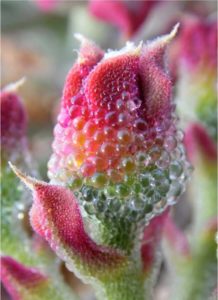
John Cushman of the University of Nevada seeks to establish the common or crystalline ice plant (Mesembryanthemum crystallinum L.) as a DOE JGI Flagship Genome species. (Image by Krzysztof Ziarnek, Wikipedia CC BY-SA 4.0)
From deep within the Earth to the upper atmosphere, the organisms and ecosystems highlighted in the 37 projects selected for the 2017 Community Science Program (CSP) of the U.S. Department of Energy Joint Genome Institute (DOE JGI), a DOE Office of Science User Facility, reflect the breadth and depth of interests researchers are exploring to find solutions to energy and environmental challenges.
“These new CSP projects, selected through our external review process, exploit DOE JGI’s experimental and analytical “omics” capabilities and build our portfolio in key focus areas including sustainable bioenergy production, plant microbiomes and terrestrial biogeochemistry,” said Susannah Tringe, DOE JGI User Programs Deputy.
The CSP 2017 projects were selected from 98 full proposals received, resulting from 123 letters of intent submitted. The full list of projects may be found at http://jgi.doe.gov/our-projects/csp-plans/fy-2017-csp-plans/.
A number of the accepted proposals call for developing reference genomes for plants of relevance to bioenergy, either as potential feedstocks or because they possess biochemistries that could provide insights into better ways to derive biofuels from plant biomass. These will take advantage of powerful DOE JGI sequencing upgrades.
Building upon the previously published reference genome for Sorghum bicolor generated by the DOE JGI, Todd Mockler of the Donald Danforth Plant Science Center has targeted the sequencing of a number of highly diverse sorghum lines. The project will explore and begin to assemble the pangenome to accelerate gene discovery and increase understanding of which variants are associated with different functional outcomes. This work is being conducted in close concert with DOE’s Advanced Research Projects Agency-Energy’s (ARPA-E) Transportation Energy Resources from Renewable Agriculture (TERRA) program.
David Des Marais of Harvard University is similarly focused on Brachypodium, which has had two genomes – Brachypodium distachyon and B. sylvaticum – sequenced by the DOE JGI. Among his plans are estimating a pangenome for B. sylvaticum and sequencing 4 additional Brachypodium species to further functional genomic analysis research in grasses.
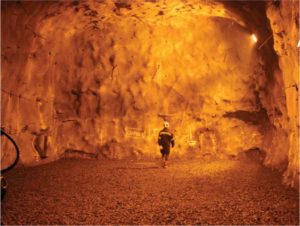
Mark Dopson of Sweden’s Linnaeus University has a project that deploys DOE JGI’s single cell genomics resources on samples sourced from the deep subsurface, including the Pyhäsalmi mine in Finland. (Courtesy of Mark Dopson)
Karen Aitken of Australia’s national science agency CSIRO is focused on producing the first genome assembly of a cultivated sugarcane plant, namely variety R570. Cultivated sugarcane produces 80 percent of the world’s sugar and is already harvested in large volumes and along with its transportation system efficiencies, is helping to guide optimized production strategies for other renewable and sustainable biofuel crops.
Many projects focus on plants with demonstrated tolerance to stressors such as drought.
The proposal from John Cushman of the University of Nevada seeks to establish the common or crystalline ice plant (Mesembryanthemum crystallinum L.) as a DOE JGI Flagship Genome species like poplar, soybean, and Brachypodium distachyon.
Most plants use what is known as the C3 pathway to photosynthetically fix carbon (from CO2) in the presence of abundant nutrients, while plants in arid conditions rely on a different mechanism, the water-conserving CAM pathway. A rapidly growing desert annual native to the Namibian desert, the common ice plant is the first reported species that can switch from the C3 pathway to CAM when stressed by factors such as drought and salinity.
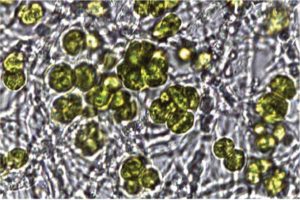
Gregory Bonito of Michigan State University will identify the mechanisms of attraction, communication, and growth-promoting activity between Mortierella, a close relative of arbuscular mycorrhizal fungi, and the DOE JGI Flagship plants. (Courtesy of Gregory Bonito)
Elizabeth Kellogg, also of the Danforth Center, requested a genome sequence for the big bluestem (Andropogon gerardii subsp. gerardii), the plant most associated with the Great Plains. The big bluestem dominates the tall grass prairie, accounting for up to 70 percent of biomass in some areas, and is highly resistant to climate change.
In a complementary project, Karolina Heyduk of the University of Georgia seeks genome sequences for two agave relatives: the C3 species Yucca aloifolia and the CAM species Y. filamentosa. Comparing the genomes of these species could illuminate the genes and pathways involved in these two forms of photosynthesis. Similarly, the gene atlas for CAM plant Kalanchoe laxiflora proposed by Xiaohan Yang of Oak Ridge National Laboratory could allow researchers to understand how it responds to changes in environmental conditions, including temperature, water, and nitrogen source.
Few conifers have had their genomes sequenced thus far, and Joerg Bohlmann of Canada’s University of British Columbia wants to raise the number. He has targeted the genomes and transcriptomes of the common yew and western red cedar, as well as the transcriptome of the Jeffrey pine, all candidate bioenergy feedstocks.
Two projects focus on the impact of fire on forests as full recovery can take decades.
Daniel Cullen of Forest Products Laboratory is comparing how microbial communities in forests dominated by Lodgepole pine (Pinus contorta) fare in fire-disturbed and undisturbed forests, in part to define processes that underlie carbon cycling in coniferous forests. Similarly, Thomas Bruns of University of California, Berkeley seeks to learn more about the effects of pyrophilous fungi on post-fire soil carbon by studying the genomes and transcriptomes of 13 fungi as well as the metatranscriptomes of burned soils.
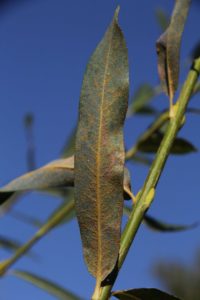
Christine Smart of Cornell University is characterizing the mechanisms of willow rust (Melampsora americana), and conducting a comparative genomic study involving Melampsora genomes sequenced by the DOE JGI that are known plant pathogens of candidate bioenergy feedstocks. (Courtesy of Christine Smart)
Several projects focus on plant-microbe interactions, both on micro- and macroscales. Sharon Doty of the University of Washington is investigating poplar endophytes, one that fixes nitrogen and one involved in phytoremediation. Plant root microbial consortia are known to be critically important to plant growth and resilience to changing soil conditions but much remains to be learned about community composition and function.
Devin Coleman-Derr of the USDA-ARS, with his resource allocation, is seeking to learn more about the role of root-associated Actinobacteria in promoting host fitness in sorghum and rice under drought conditions.
Paul Dijkstra of Northern Arizona University, with his allocation, will illuminate soil bacterial transcriptional regulatory networks in switchgrass fields.
William Whitman of the University of Georgia plans to develop pangenomes of 100-200 species of soil or plant-associated prokaryotes. The pangenome concept is vital to understanding the repertoire of genes upon which microbial populations may call as local environments change.
Other projects focus on plant-fungal interactions.
Jared LeBoldus of Oregon State University is targeting metabolites of Sphaerulina musiva, the cause of Septoria stem canker and leaf spot disease in poplar.
Christine Smart of Cornell University is characterizing the mechanisms of willow rust (Melampsora americana), and conducting a comparative genomic study involving M. americana and other Melampsora genomes sequenced by the DOE JGI that are known plant pathogens of poplar and other candidate bioenergy feedstocks.
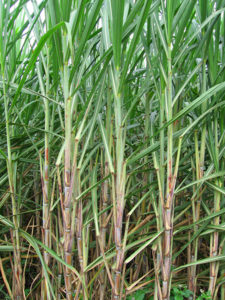
Karen Aitken of Australia’s national science agency CSIRO is focused on producing the first genome assembly of a cultivated sugarcane plant. (Image by Karen Aitken, CSIRO)
Gregory Bonito of Michigan State University will identify the mechanisms of attraction, communication, and growth-promoting activity between Mortierella, a close relative of arbuscular mycorrhizal fungi, and the DOE JGI Flagship plants.
Nhu Nguyen of the University of Hawai’i at Manoa will be a generating genus-wide molecular phylogeny of Suillus, asking for 50 fungal genome sequences. Suillus fungi tolerate heavy metals, but the protection varies among hosts.
Wayne Nicholson of the University of Florida will be generating a more comprehensive assessment of Carnobacterium, strains of which can be found in all pressure niches from the deep ocean to the upper atmosphere.
Sean Crowe of Canada’s University of British Columbia will characterize the methanome, comprised of genomic information distributed across organisms that either produce or consume methane, which is both a source of fuel and a greenhouse gas.
Graeme Attwood of New Zealand’s AgResearch Ltd and his team seek to define gene function in rumen microbes, in part to control the microbes’ production of methane emissions from bovines.
Soil emissions are a focus of Jennifer Pett-Ridge of Lawrence Livermore National Laboratory and Jonathan Raff of Indiana University. Pett-Ridge is determining the impact microbes in humid tropical forest soils have on carbon cycling, work that complements her DOE Early Career Research Program award. Raff intends to use samples from temperate hardwood forest sites to learn more about soil emissions of nitric oxide (NO) and more accurately represent NO sinks and sources in climate models.
Alison Buchan of University of Tennessee, Knoxville is generating data about lignin related aromatic compounds in salt marshes that are removed between river mouths and open oceans, and the biochemical pathways employed in this process.
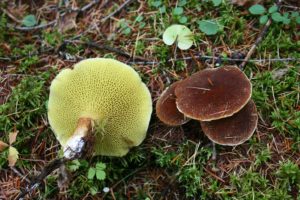
Suillus ampliporus, shown here, is part of the genus-wide molecular phylogeny of Suillus project from Nhu Nguyen of the University of Hawai’i at Manoa. (Image by Nhu Nguyen)
A similar project comes from Christopher Francis of Stanford University and involves the San Francisco Bay Delta, the largest estuary on the west coast of North America. His team is investigating how environmental changes drive estuarine microbial community changes, and if certain pathways and organisms dominate under certain conditions, or if genes co-vary with specific functional gene ecotypes.
Several projects are focused on algae for their roles in carbon fixation and for potential bioenergy applications.
Chi Zhang of the University of Nebraska – Lincoln is focused on Zygnematales, the closest algal lineage to land plants, to learn more about how plant cell walls formed in the evolutionary transition from aquatic to land plants. The information could shed light on how to deconstruct plant cell walls for biofuel production without impacting plant viability.
Matthew Johnson of Woods Hole Oceanographic Institute is interested in the bloom-forming Mesodinium rubrum and M. major complex. While these algae are major contributors to primary production, they acquire their ability to harness light energy for nutrients through predation so genome sequencing would help distinguish native metabolic pathways from those of the prey.
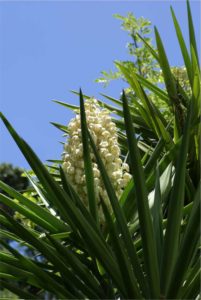
Karolina Heyduk of the University of Georgia seeks genome sequences for agave-related species: the C3 species Yucca aloifolia, shown here, and the CAM species Y. filamentosa. (Image by Rolf Engstrand, Wikipedia CC BY-SA 3.0)
Jeffry Dudycha of the University of South Carolina is pursuing a project based on cryptophytes, eukaryotic microalgae that are important primary producers in aquatic environments and are capable of capturing a broad spectrum of available light. By sequencing representatives from all major clades, the team hopes to maximize ways diverse algal communities could boost lipid yields for biofuels.
Biological soil crusts or biocrusts are extremely sensitive to climate changes. As surviving extreme drought is a rare feature in plants, Elena Lopez Peredo of Marine Biological Laboratory will be generating annotated genomes of Scenedesmus algae to learn more about the desiccation tolerance of green microalgae in biocrusts.
In a complementary project, Steven Harris of University of Nebraska – Lincoln is detailing the interactions of fungal and algal components of biocrusts to learn more about how they can tolerate environmental stress.
Several projects build off previous efforts to sequence 1,000 microbial genomes (KMG), which have so far led to the selection of nearly 2,300 type strains. Markus Göker of Germany’s DSMZ is spearheading KMG-4 to sequence environmentally relevant cultures. Ramunas Stepanauskas of Bigelow Laboratory for Ocean Sciences is using single-cell genomics to target taxonomic “blind spots” – clades systematically underrepresented or missed due to primer mismatches or intervening sequences in marker genes.
Barbara MacGregor of the University of North Carolina is exploring how horizontal gene transfer has shaped the genomes of large sulfur bacteria, which are often found in dense microbial mats and play roles in carbon, nitrogen, sulfur and phosphorus cycles.
Mary Ann Moran of the University of Georgia is examining organic sulfur biogeochemistry in a coastal ocean ecosystem. She and colleagues from the Monterey Bay Aquarium Research Institute collected a time series of coastal microbes and microbial communities which will be subjected to sequencing to explore how metabolism shifts as community composition changes.
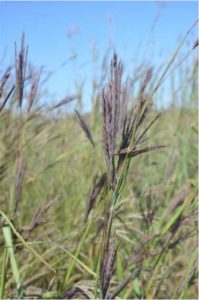
Elizabeth Kellogg requested a genome sequence for the big bluestem (Andropogon gerardii subsp. gerardii), the plant most associated with the Great Plains. (Image by Jeremy Schmutz, HudsonAlpha Institute for Biotechnology)
Mark Dopson of Sweden’s Linnaeus University has a project that deploys DOE JGI’s single cell genomics resources on samples sourced from deep subsurface. Targeted microbiomes will come from deep bedrock waters including Mont Terri Underground Rock Lab in Switzerland and sites constructed to investigate the safety of deep geological storage of spent nuclear fuel. Data would provide knowledge contributing to informed decisions on safety.
Ashley Shade of Michigan State University plans to use a synthetic bacterial community to study the interactions among multiple community members, and then link community structure to activity and to exometabolite interactions.
In sum, these 37 new projects will furnish a genomic basis for ongoing and new explorations into the genetic bases for plant, fungal, algal, microbial, and microbial community mechanisms focused on important processes of biofuel and bioenergy feedstock composition and metabolisms, as well as related environmental processes of importance for DOE missions.